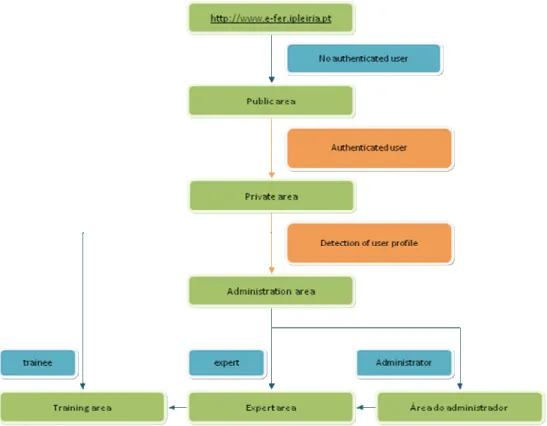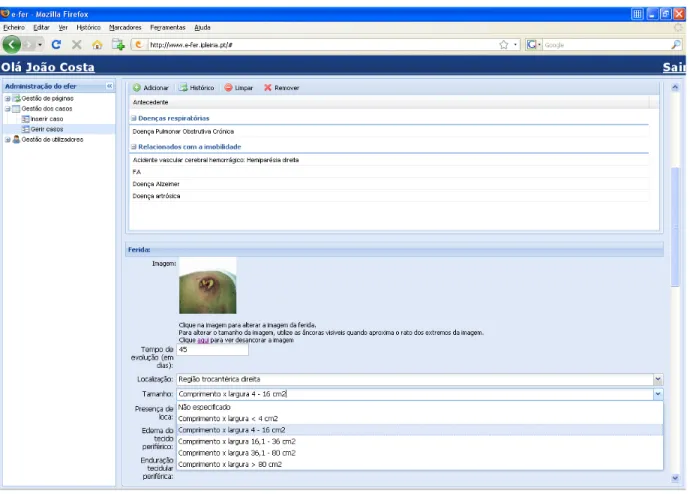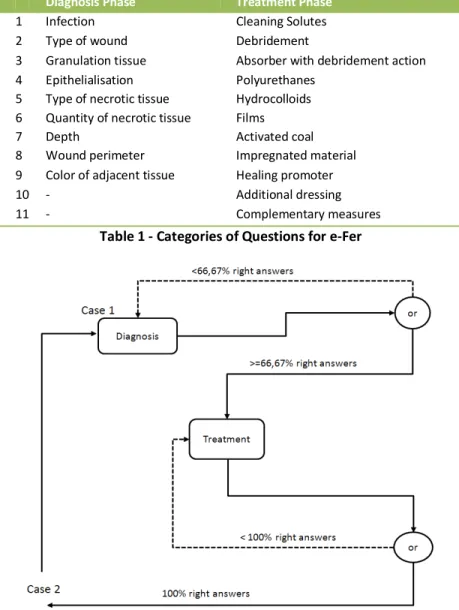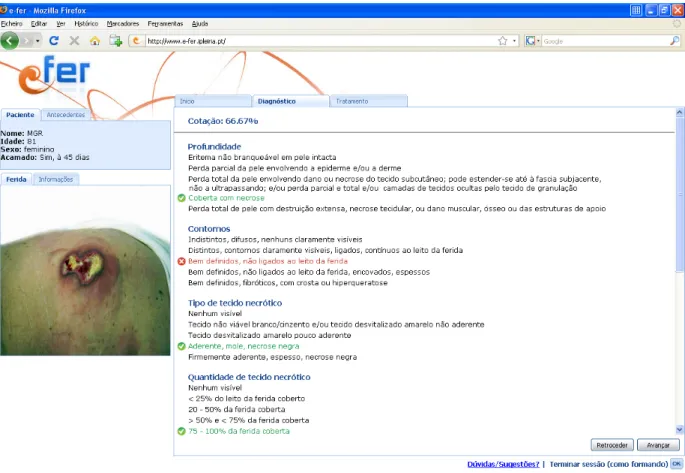Towards an Adaptive Web Based Learning Environment for Treating and
Diagnosing Chronic Wounds
João Costa , Polytechnic Institute of Leiria, Portugal Gustavo Santos , Carnegie Mellon University, USA Pedro Gaspar , Polytechnic Institute of Leiria, Portugal Rogério Costa , Polytechnic Institute of Leiria, Portugal Joaquin Fernandez , Polytechnical University of Catalonia, Spain
Josep Monguet , Polytechnical University of Catalonia, Spain Paper present at ED-MEDIA 2009--World Conference on Educational Multimedia, Hypermedia & Telecommunications, Honolulu, HI, USA, June 22-26, 2009.
Abstract: A wise decision when choosing adequate products to treat chronic wounds depends on proper diagnosis and characterization of the chronic wound. Developing skills for treating and diagnosing chronic wounds requires not only academic knowledge, but also other types of knowledge not easily acquired through traditional instructional methodologies. The expertise obtained by individuals, when they are solving real life practical cases, is very important to diagnose and correctly treat chronic wounds. This additional empirical knowledge is not easily transmitted in classrooms, and so the academic instruction should be completed with real life practical examples and practical cases. The e-Fer Web Based Learning Environment for chronic wounds, is a case based learning tool for assisting nursing students to develop skills for diagnosing and treating chronic wounds. This paper will briefly describe some characteristics of the platform, and our main goal is to present our novel approach to implement the adaptive version of the learning environment. We are also going to discuss our user model, and the types of learning support that we decided to implement in the system.
I - Introduction
Developing skills for diagnosing and treating various diseases requires not only academic knowledge, but also practical not easily acquired by attending a lecture or reading a textbook. The expertise obtained by individuals, when they are solving real life practical cases, is very important for future doctors and nurses, but the student expose to these cases is typically limited. To increase student expose to real life cases, the universities more and more frequently develop simulation environments – from immersive simulation to simpler Web-based learning environments. Yet, even most sophisticated of these environments are not as effective as they could be since they are not able to adapt to knowledge and skill level of individual students. Each students exposed to a simulation environment gets access to the same cases regardless of their past preparations and skills acquired during their training.
The paper explores the problem of building adaptive Web-based learning environments for medical training using a specific case of E-Fer, a Web Based Learning Environment [1] to assist nursing students in the development of skills for diagnosing and treating chronic wounds. This paper will briefly describe some characteristics of E-Fer and proposes a novel approach form making this learning environment adaptive. We discuss our user model, and the types of learning support that we decided to implement in the system.
The adaptive teaching model that we will implement is based on two core types of learning support, worked examples [2] and problem solving. Other types of learning support are currently presented in the platform, such as minimal feedback, error specific feedback, problem solving support and a simple form of adaptive sequencing. To implement advanced adaptivity, our user model will measure two types of knowledge, demonstrated and exposed. The demonstrated knowledge represents the knowledge that students show to have for
solving problems in the system. The exposed knowledge represents the level of exposition that students have about concepts or skills. For estimating the level of proficiency of each skill that students have to master, we combine the demonstrated knowledge and the exposed knowledge of users. Those values can be combined together to calculate the overall estimated level of proficiency of each skill.
II - E-Fer: A Web Based Learning Environment Focused on Chronic Wounds
A wise decision when choosing adequate products to treat chronic wounds depends on proper diagnosis and characterization of the chronic wound. Being able to make good decisions in terms of treatment is also important to improve the quality of service and minimize the costs. The main goal of the e-Fer Web Based Learning Environment is developing and training skills for diagnosing and treating chronic wounds. The platform is available over the internet and is currently being used by nursing students of the Portuguese Polytechnic Institute of Leiria (see http://www.e-fer.ipleiria.pt/).
Figure 1: General System Workflow and User roles
Figure 1 show the general system workflow and user roles for e-Fer. After accessing the system, users need to authenticate to use the platform. Administrators have full access to the content of the learning environment. They can change the content of the study cases, and also manage general information using a Web-CMS. Experts are responsible for inserting new real life practical cases to be solved. Trainees will access the system to complete their instruction on diagnosing and treating chronic wounds.
A group of national experts on chronic wounds are registered in the e-Fer platform. They are responsible for introducing and preparing new clinical cases in the system. Each case represents an exact description of a real life case, and to be solved requires a very careful analysis of the information available. The process of creating
virtual cases takes just a few minutes and the cases are stored in a database. All cases are reviewed by a special group of three experts taking part in the development of the system. They verify and analyze the information introduced by other experts and guarantee the feasibility of the cases. After revision, the cases will be available in the platform and can be distributed to students meeting the requirements to solve them. To create a new case, experts have to introduce the following specifications:
• Degree of difficulty: Basic, Medium, Advanced, or Expert • Patient’s data: Nickname, Sex and Age
• Patient’s past medical history: All the past medical information about the individual • Wound information: All information about the wound including a picture
Figure 2 - Creating a Case
To solve a case the student needs to go through to two distinct phases, diagnosis and treatment. The first phase is the diagnosis. There are 9 categories of questions forming this phase. Each question has several options in a dropdown list. The objective is to verify if the student is able to correctly identify, and classify symptoms of the wound consulting the information available. It is up to experts to decide about the best diagnosis solution and specify it when introducing the case in the platform. The suggested solution submitted by the student will be evaluated, and the system will determine the number of correct answers. After submission, the student receives specific feedback by the system about the quality of his submission. To proceed to treatment phase, students need to have at least 66.67% of correct answers in the diagnosis. This threshold was defined by the experts and if it is not satisfied students have to redo the diagnosis phase again.
The categories of questions in Table 1 can also be seen as skills. For example, in the diagnosis phase answering question 2 requires the skill of being able to identify the type of wound. Question 5 requires the skill of
identifying the type of necrotic tissue, and so on. Questions can also be classified as easy or hard. For example, we can have a case where identifying the type of wound is easy, and identifying the type of necrotic tissue is hard, or vice versa.
Categories of Questions
Diagnosis Phase Treatment Phase
1 Infection Cleaning Solutes 2 Type of wound Debridement
3 Granulation tissue Absorber with debridement action 4 Epithelialisation Polyurethanes
5 Type of necrotic tissue Hydrocolloids 6 Quantity of necrotic tissue Films 7 Depth Activated coal 8 Wound perimeter Impregnated material 9 Color of adjacent tissue Healing promoter 10 - Additional dressing 11 - Complementary measures
Table 1 - Categories of Questions for e-Fer
Figure 3 - Workflow for Solving Cases
The treatment phase has 11 categories of questions. Each group has a set of checkboxes forming a list of products. Students have to select in each group the products that should be used to heal the wound. Every product has a value associated (+1, 0, -1). If the wound gets better after applying a product, the associated value is (+1). If the state remains the same, the associated value is (0). If the wound gets worse, the associated value is (-1). The values are used to evaluate students’ final answer. When students can get 100% proficiency answering questions in the treatment phase, a new problem will be suggested.
The system now only has a simple form of adaptive sequencing [3]. E-Fer has cases with four levels of difficulty (basic, medium, advanced and expert). To select the next problem to be solved, several aspects about students are taken into consideration, for example, student’s academic degree, professional experience, self-assessment of skills, and number of cases already solved. However, this approach is quite simple because almost all the information that the system has about students is acquired when they submit the registration form. The number of cases solved is the only parameter that is determined dynamically when students are interacting with the platform. A better adaptive approach could make students learn more and make the system more efficient. For example, the efficiency of the system could be increased with a bigger number of cases available. Nevertheless,
increasing the number of real life cases in e-Fer is a slow process. In this paper we will explain how we can make better use of the number of cases using adaptive presentation [4].
Figure 4 - Solving a Case
III - User Model
To implement an adaptive system, one of the core components is the user model [5]. In this section we are describing e-Fer’s proposed user model to implement advanced adaptivity. Our user model will measure two types of knowledge for each skill, demonstrated and exposed. The demonstrated knowledge represents the knowledge that students show to have acquired. The exposed knowledge represents the level of exposition that students have about concepts or skills. This knowledge will be determined when students are operating with interactive worked-out examples with self explanation quizzes. For estimating the level of proficiency of each skill, we combine the demonstrated knowledge and the exposed knowledge of users. Those values can be combined together to calculate the overall estimated level of proficiency of each skill. Figure 5 illustrates the measured knowledge of a single skill using a “skillometer” representation.
Exposed Knowledge Demonstrated Knowledge
1
Exposed Knowledge Demonstrated Knowledge
2
Exposed Knowledge Demonstrated Knowledge
3
Exposed Knowledge Demonstrated Knowledge
Figure 5 - Workflow for Solving Cases
When students enter the system for the first time, the exposed knowledge and the demonstrated knowledge will be initialized in the level zero (see figure 5.1). To estimate the initial knowledge of users about the skills, a pre-test can be performed before students start solving cases. This pre-test will increase the demonstrated knowledge of some skills (see figure 5.2). After start working on cases, the demonstrated knowledge and the exposed knowledge will vary. They can increase, stay in the same level or decrease.
The exposed knowledge will increase when the system presents a worked-out example to the student. The example will show information about a particular skill and should be examined by the user. After that, a self explanation quiz will be showed to evaluate the acquisition of knowledge, and to make sure that the student understood the example. If the student answers the quiz correctly, the exposed knowledge of the skill will increase one level in the model (see figure 5.3). We should stress that after answering the quiz correctly; we don’t increase the demonstrated knowledge. It is important to define here that the demonstrated knowledge is a measure procedural knowledge, in other words, the ability of being able to apply knowledge. The exposed knowledge is a measure of declarative knowledge, i.e., what is known about a skill and it cannot be used as evidence that students can actually apply this knowledge correctly.
The exposed knowledge in our approach actually never decreases. If students don’t answer the quiz correctly, we ask them to analyze the example again and redo the quiz until they answer it correctly. Redoing the quiz over and over is probably not the best way to address this issue. So far we did not come up with a better way to do that, and we will probably improve this in the future. Nevertheless, this assures at least that users know some about the skill - if they do not “game the system” [6] when answering quizzes.
The demonstrated knowledge can change dynamically when students are solving cases. It will increase when they demonstrate ability of using skills, but it will also decrease when they make errors applying skills (see figure 5.4). The next section will explain when students are shown worked-out examples, or problems to solve.
IV - Teaching Model
To explain our teaching model, we first present the desired architecture to support the adaptive version of e-Fer (see figure 6).
Figure 6 - System Architecture
When students access the system to solve problems, a list with the most suitable cases will be presented in an Adaptive Hypermedia [7] fashion. Classifying cases to create the list will be done by the adaptation module using the adaptation rules and the user model (see figure 6). With Adaptive Presentation the selected cases will be assembled dynamically to fit user’s needs. This will be a very important feature, because it makes possible to use of the repository of cases in many different ways.
Having real life cases in the platform to suit every possible combination of mastered/not mastered skill it is not suitable. For instance, if a student is very good on identifying the type of wound, and not good on identifying the type of necrotic tissue, we should have in the platform a case were identifying the type of wound is hard, and identifying the type of necrotic tissue is easy. Considering the number of possible combinations of mastered/not mastered skills, and the time that is necessary to acquire more cases, it is just not feasible to have this amount of cases in the system.
When the system suggests cases, it takes in consideration the overall difficulty of the cases, and the overall knowledge of the user. Both values can be calculated mathematically. Nevertheless, considering only the overall difficulty the system can for example, suggest a case where the question “identifying the type of wound” is hard, and using the exposed knowledge and the demonstrated knowledge for this skill, we determine that the student does not have enough knowledge to answer this question.
When students seem to have enough knowledge to answer a question, we just let them try. When they do not seem to have enough knowledge to answer a question, we can provide the answer for this question and also put a hyperlink to a worked example about this skill with a self explanation quiz. After going through the worked example, the exposed knowledge will be updated in the user model, and in the future the updated user model will influence the next suggestion of cases and also the next case presentation.
V - Conclusions and Future Work
To implement the proposed teaching model, an adaptation model is being developed using the exposed knowledge and the demonstrated knowledge. We are specifying thresholds to determine when the system should show an example, or let the student try to answer a question. We identified four regions to be defined in terms of values. (1) The question is easy to solve and the student have enough knowledge to solve the question. (2) The question is easy to solve and the student does not have enough knowledge to solve the question. (3) The question is hard to solve and the student have enough knowledge to solve the question. (4) The question is hard to solve and the student does not have enough knowledge to solve the question. We have also to define weights for the demonstrated knowledge and the exposed knowledge.
The paper presented our teaching model for a web based learning environment for assisting nursing students to develop skills for diagnosing and treating chronic wounds. We described some characteristics of the platform, and presented our novel approach to implement the adaptive version of the learning environment. Our approach is based on measuring two different types of knowledge, demonstrated and the exposed. It is also based on two core types of learning support, worked examples and problem solving.
VI – References – To be formatted as well
[1] João Costa. e-Fer, a Web Based Learning Environment for Treating and Diagnosing Chronic Wounds.
http://www.e-learning.estg.ipleiria.pt/
[2] Salden et. al. Worked Examples and Tutored Problem Solving: Redundant or Synergistic Forms of Support? CogSci 2008.
[3] Peter Brusilovsky and Julita Vassileva. Course sequencing techniques for large-scale web-based education. International Journal of Continuing Engineering Education and Life Long Learning. 2003
[5] Alfred Kobsa. Generic User Modeling Systems. Journal of User Modeling and User-Adapted Interaction. 2004 [6] Ryan Shaun Baker. Off-task behavior in the cognitive tutor classroom: when students "game the system". Conference on Human Factors in Computing Systems 2004




